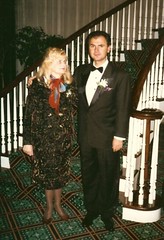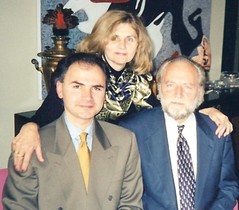Blog Archives
Looking towards San Giorgio Maggiore, Venice
Via Flickr:San Giorgio Maggiore is a basilica in Venice, Italy designed by Andrea Palladio and located on the island of San Giorgio Maggiore. Facing Saint Mark Basin, the church plays a central role in the panorama from the Piazzetta. – <a href=
St. Peter’s square with the egyptian obelisk, Rome
Via Flickr:The Egyptian obelisk in the middle of St. Peter’s square is of red granite, 25.5 meters tall, supported on bronze lions and surmounted by the Chigi arms in bronze, in all 41 meters to the cross on its top. The obelisk, of the 13th century BC, was moved to Rome in AD 37 by the Emperor Caligula to stand in the central spina of the Circus Gai et Neronis, which lay to the left of the present basilica. It was moved to its current site in 1586 by the engineer-architect Domenico Fontana under the direction of Pope Sixtus V; the engineering feat of re-erecting its vast weight was memorialized in a suite of engravings (illustrated right). The Vatican Obelisk is the only obelisk in Rome that has not toppled since ancient Roman times. During the Middle Ages, the gilt ball on top of the obelisk was believed to contain the ashes of Julius Caesar.[5] Fontana later removed the ancient metal ball, now in a Rome museum, that stood atop the obelisk and found only dust. Though Bernini had no influence in the erection of the obelisk, he did use it as the centerpiece of his magnificent piazza. – <a href=
Fountain in St. Peter’s square, Rome
Via Flickr:One of the two fountains in a St. Peter’s square in Rome. This one (to the right of the obelisk) is actually not by Fontano but by Carlo Maderno. Bulb has gone on the light in Fontana’s fountain so I couldn’t take the picture, but the name just sounded too good. Guess where rome challenge: Wherу is this taken and which architect is this fountain by?
Cupola of Sant Andrea della Valle, Rome
Via Flickr:Sant’Andrea della Valle is a basilica church in Rome, in the rione of Sant’Eustachio. It was initially planned when Donna Costanza Piccolomini d’Aragona, duchess of Amalfi and descendant of the family of Pope Pius II[1], bequeathed her palace and the adjacent church of San Sebastiano in central Rome to the Theatine order for construction of a new church. Since Amalfi’s patron was Saint Andrew, the church was planned in his honor. Work initially started around 1590 under the designs of Giacomo della Porta and Pier Paolo Olivieri, and under the patronage of Cardinal Gesualdo. With the prior patron’s death, direction of the church passed to Cardinal Alessandro Peretti di Montalto, nephew of Sixtus V. By 1608, and banked by the then enormous endowment of over 150 thousand gold scudi, work restarted anew with a more grandiose plans mainly by Carlo Maderno. The interior structure of the church was finally completed by 1650, with additional touches added by Francesco Grimaldi. – <a href=
Gallery in Vatican Museums
Via Flickr:The ceiling in one of the halls in Vatican Museums. If someone knows the exact name please let me know in comments.The Vatican Museums trace their origin to one marble sculpture, purchased 500 years ago. The sculpture of Laocoön, the priest who, according to Greek mythology, tried to convince the people of ancient Troy not to accept the Greeks’ “gift” of a hollow horse, was discovered 14 January 1506, in a vineyard near the basilica of Santa Maria Maggiore in Rome. Pope Julius II sent Giuliano da Sangallo and Michelangelo Buonarroti, who were working at the Vatican, to examine the discovery. On their recommendation, the pope immediately purchased the sculpture from the vineyard owner. The pope put the sculpture of Laocoön and his sons in the grips of a sea serpent on public display at the Vatican exactly one month after its discovery.The Museums celebrated their 500th anniversary in October 2006 by permanently opening the excavations of a Vatican Hill necropolis to the public. – <a href=
Sultan Ahmed Mosque at night, Istanbul
Via Flickr:The mosque stands on the remains of the byzantine hippodrome, of which the only remainders are the 2 obelisks (highlighted)The Sultan Ahmed Mosque (Turkish: Sultanahmet Camii) is the national mosque of Turkey, and is a historical mosque in Istanbul, the largest city in Turkey and the capital of the Ottoman Empire (from 1453 to 1923). The mosque is one of several mosques known as the Blue Mosque for the blue tiles adorning the walls of its interior. It was built between 1609 and 1616, during the rule of Ahmed I. Like many other mosques, it also comprises a tomb of the founder, a madrasah and a hospice. The Sultan Ahmed Mosque has become one of the greatest tourist attractions of Istanbul. – <a href=
Theotokos Mosaic, Hagia Sophia, Constaninople
Via Flickr:Hagia Sophia (Turkish: Ayasofya, from the Greek: Αγία Σοφία, “Holy Wisdom”; Latin: Sancta Sophia or Sancta Sapientia) is a former patriarchal basilica, later a mosque, now a museum in Istanbul, Turkey. Famous in particular for its massive dome, it is considered the epitome of Byzantine architecture. It was the largest cathedral ever built in the world for nearly a thousand years, until the completion of the Seville Cathedral in 1520. The current building was originally constructed as a church between A.D. 532 and 537 on the orders of the Byzantine Emperor Justinian, and was in fact the third Church of the Holy Wisdom to occupy the site (the previous two had both been destroyed by riots). It was designed by two architects, Isidore of Miletus and Anthemius of Tralles. The Church contained a large collection of holy relics and featured, among other things, a 50 foot (15 m) silver iconostasis. It was the patriarchal church of the Patriarch of Constantinople and the religious focal point of the Eastern Orthodox Church for nearly 1000 years. – <a href=
Mosaic of Christ in Karye Museum (Chora Church), Istanbul
Via Flickr:Central part of the Mosaic of Christ Pantocrator, south dome of inner narthex.The Chora Church was originally built outside the walls of Constantinople, to the south of the Golden Horn. Literally translated, the church’s full name was the Church of the Holy Saviour in the Country: although “The Church of the Holy Redeemer in the Fields” would be a more natural rendering of the name in English. (Greek ἡ Ἐκκλησία του Ἅγιου Σωτῆρος ἐν τῃ Χώρᾳ, hē Ekklēsia tou Hagiou Sōtēros en tē Chōra).[2] The last part of that name, Chora, referring to its location originally outside of the walls, became the shortened name of the church. The original church on this site was built in the early 5th century, and stood outside of the 4th century walls of Constantine the Great. However, when Theodosius II built his formidable land walls in 413–414, the church became incorporated within the city’s defences, but retained the name Chora. The name must have carried symbolic meaning, as the mosaics in the narthex describe Christ as the Land of the Living (ἡ Χώρα των ζώντων, hē Chōra tōn zōntōn) and Mary, the Mother of Jesus, as the Container of the Uncontainable (ἡ Χώρα του Ἀχώρητου, hē Chōra tou Achōrētou). – <a href=
Musée d’Orsay
Via Flickr:The Musée d’Orsay is a museum in Paris, France, on the left bank of the Seine, housed in the former railway station, the Gare d’Orsay. It holds mainly French art dating from 1848 to 1915, including paintings, sculptures, furniture, and photography, and is probably best known for its extensive collection of impressionist masterpieces by such painters such as Monet, Degas, Renoir, and Cezanne. Many of these works were held at the Galerie nationale du Jeu de Paume prior to the museum’s opening in 1986. – <a href=
Paris Sunset from the Louvre Window
Via Flickr:The Louvre Museum (French: Musée du Louvre), located in Paris, is a historic monument, and a national museum of France. It is a central landmark, located on the Right Bank of the Seine in the 1st arrondissement (neighbourhood). Nearly 35,000 objects from the 6th millennium BC to the 19th century AD are exhibited over an area of 60,600 square metres (652,300 square feet).The museum is housed in the Louvre Palace (Palais du Louvre) which began as a fortress built in the 12th century under Philip II. Remnants of the fortress are still visible. The building was extended many times to form the present Louvre Palace. In 1674, Louis XIV chose the Palace of Versailles for his household, leaving the Louvre primarily as a place to display the royal collection. During the French Revolution, the National Assembly decreed that the Louvre should be used as a museum, to display the nation’s masterpieces.The museum opened on 10 August 1793 with an exhibition of 537 paintings, the majority of the works being confiscated church and royal property. Because of structural problems with the building, the museum was closed in 1796 until 1801. The size of the collection increased under Napoleon when the museum was renamed the Musée Napoléon. After his defeat at Waterloo, many works seized by Napoleon’s armies were returned to their original owners. The collection was further increased during the reigns of Louis XVIII and Charles X, and during the Second Empire the museum gained 20,000 pieces. Holdings have grown steadily through donations and gifts since the Third Republic, except during the two World Wars. As of 2008, the collection is divided among eight curatorial departments: Egyptian Antiquities; Near Eastern Antiquities; Greek, Etruscan, and Roman Antiquities; Islamic Art; Sculpture; Decorative Arts; Paintings; and Prints and Drawings. – <a href=












